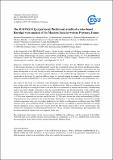Por favor, use este identificador para citar o enlazar a este item:
http://hdl.handle.net/10261/203239COMPARTIR / EXPORTAR:
 SHARE
BASE SHARE
BASE
|
|
| Visualizar otros formatos: MARC | Dublin Core | RDF | ORE | MODS | METS | DIDL | DATACITE | |

| Título: | The MAUPASACQ experiment: Preliminary results of a noise-based Rayleigh wave analysis of the Mauleon Basin in western Pyrenees, France |
Autor: | Giannopoulos, Dimitrios; Lois, A.; Leontarakis, Konstantinos; Polychronopoulou, K.; Martakis, N.; Calassou, Sylvain; Collins, Magali; Chevrot, S.; Sylvander, Matthieu; Villaseñor, Antonio CSIC ORCID CVN ; Diaz, J. CSIC ORCID ; Bitri, A. | Fecha de publicación: | 7-abr-2019 | Editor: | European Geosciences Union | Citación: | Geophysical Research Abstracts, 21: EGU2019-12707 (2019) | Resumen: | In the framework of the MAUPASACQ project, a dense seismic network of 440 three-component stations was deployed throughout the Mauleon Basin, in the northern foothills of the Pyrenees, SW France. The network consisted of three different types of sensors, namely 190 SG-10 SERCEL geophone nodes, 197 5 Hz SEISMOTECH short-period sensors and 53 broadband sensors (Guralp CMG-40, Trillium Compact, Trillium 120), and operated continuously for 6 months, from April 1 until September 30, 2017. Numerous geological and geophysical observations provide evidence that the Mauleon Basin was created by the tectonic inversion of a precollisional rift system that was formed between the Iberian and European plates, involving processes of rift-related mantle exhumation. These observations, among others, characterize the area under investigation as an ideal locality to study and understand the structural and geodynamic evolution of the Pyrenean mountain range. The main scientific objective of the MAUPASACQ experiment is to provide new constraints on this topic, by applying different types of classical imaging techniques that incorporate a number of Passive Seismic methodologies (i.e. travel time tomography, ambient noise tomography, receiver functions, etc.). The scope of this work is to illustrate some preliminary observations deriving from the analysis of the ambient seismic noise field that was recorded in the Mauleon Basin. This was achieved by beamforming and by using the Rayleigh wave empirical Green’s functions that were estimated by seismic interferometry. Beamforming analysis provided valuable information about the spatial distribution and the directionality of the ambient noise sources. The main source region for the primary microseisms (12-20 s) is located to the northwest (N315o), being present over a larger backazimuth range across the northwest quadrant, while the secondary microseisms (5-10 s) seem to present two maxima, one in the west (N270o) and a second one in the north-northwest (N350o), ranging between west-southwest and north directions. Furthermore, 1-day long recordings between all available vertical components were cross correlated, stacked over the whole recording period, resulting in more than 90000 reference noise cross-correlation stacks. A frequency-time analysis was applied to measure Rayleigh wave group velocity dispersion curves, which were used to invert for 2D velocity maps in the 1 to 10 s period range. The results reveal the presence of interesting and distinctive velocity structures, demonstrating a good agreement with the major geological features that were expected in the area. The preliminary observations of the current analysis highlight the sufficiency and the potential of the MAUPASACQ array to use ambient seismic noise recordings as a standalone, as well as a complementary tool towards the investigation of the shear velocity structure beneath the Mauleon Basin. | Descripción: | EGU General Assembly 2019, in Viena, Austria, 7–12 April 2019 | Versión del editor: | https://www.geophysical-research-abstracts.net/egu2019.html | URI: | http://hdl.handle.net/10261/203239 | Identificadores: | issn: 1029-7006 |
| Aparece en las colecciones: | (Geo3Bcn) Comunicaciones congresos |
Ficheros en este ítem:
| Fichero | Descripción | Tamaño | Formato | |
|---|---|---|---|---|
| Diaz_EGU2019-12707.pdf | 40,12 kB | Adobe PDF |  Visualizar/Abrir |
CORE Recommender
Page view(s)
158
checked on 30-abr-2024
Download(s)
51
checked on 30-abr-2024
Google ScholarTM
Check
Este item está licenciado bajo una Licencia Creative Commons

